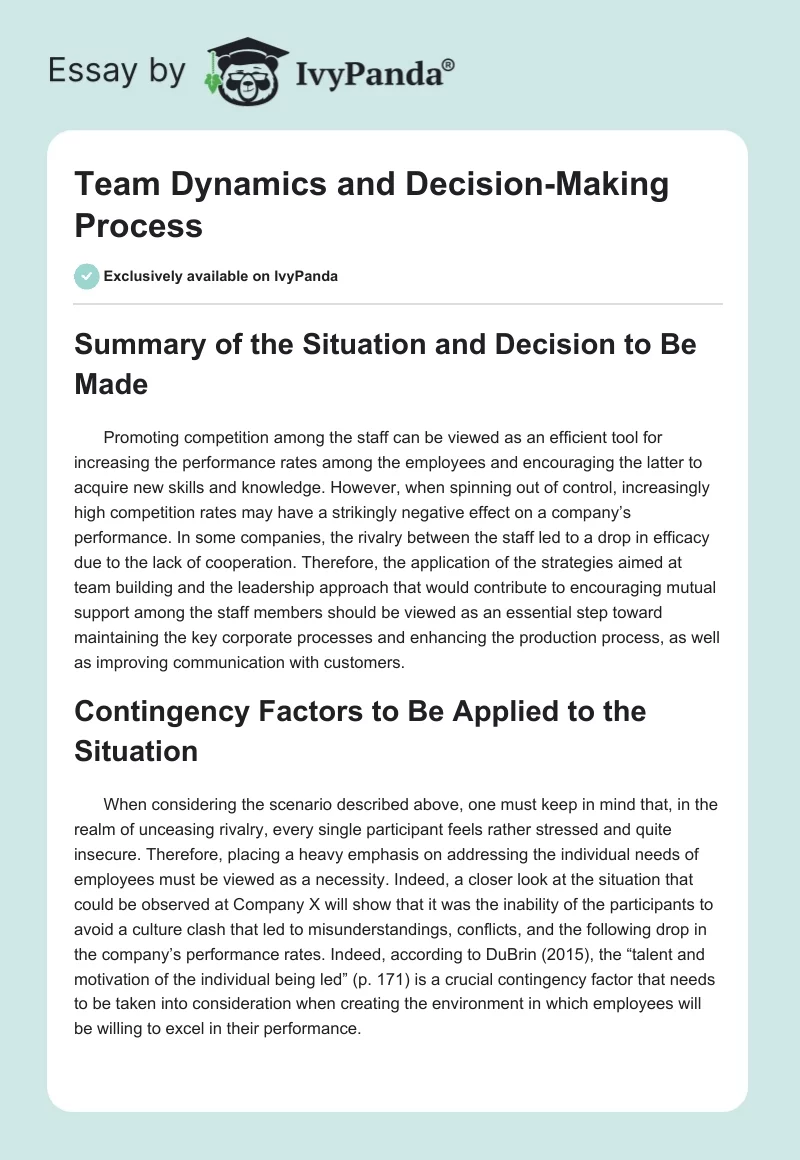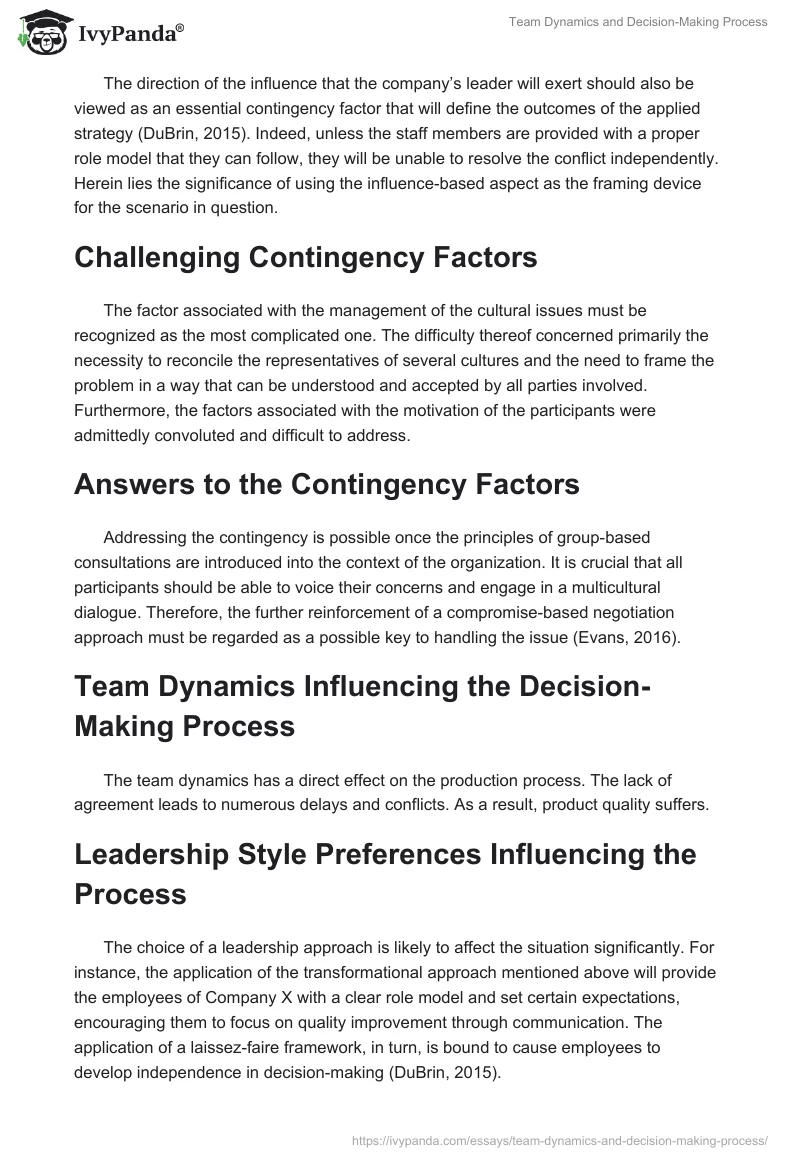Summary of the Situation and Decision to Be Made
Promoting competition among the staff can be viewed as an efficient tool for increasing the performance rates among the employees and encouraging the latter to acquire new skills and knowledge. However, when spinning out of control, increasingly high competition rates may have a strikingly negative effect on a company’s performance. In some companies, the rivalry between the staff led to a drop in efficacy due to the lack of cooperation. Therefore, the application of the strategies aimed at team building and the leadership approach that would contribute to encouraging mutual support among the staff members should be viewed as an essential step toward maintaining the key corporate processes and enhancing the production process, as well as improving communication with customers.
Contingency Factors to Be Applied to the Situation
When considering the scenario described above, one must keep in mind that, in the realm of unceasing rivalry, every single participant feels rather stressed and quite insecure. Therefore, placing a heavy emphasis on addressing the individual needs of employees must be viewed as a necessity. Indeed, a closer look at the situation that could be observed at Company X will show that it was the inability of the participants to avoid a culture clash that led to misunderstandings, conflicts, and the following drop in the company’s performance rates. Indeed, according to DuBrin (2015), the “talent and motivation of the individual being led” (p. 171) is a crucial contingency factor that needs to be taken into consideration when creating the environment in which employees will be willing to excel in their performance.
The direction of the influence that the company’s leader will exert should also be viewed as an essential contingency factor that will define the outcomes of the applied strategy (DuBrin, 2015). Indeed, unless the staff members are provided with a proper role model that they can follow, they will be unable to resolve the conflict independently. Herein lies the significance of using the influence-based aspect as the framing device for the scenario in question.
Challenging Contingency Factors
The factor associated with the management of the cultural issues must be recognized as the most complicated one. The difficulty thereof concerned primarily the necessity to reconcile the representatives of several cultures and the need to frame the problem in a way that can be understood and accepted by all parties involved. Furthermore, the factors associated with the motivation of the participants were admittedly convoluted and difficult to address.
Answers to the Contingency Factors
Addressing the contingency is possible once the principles of group-based consultations are introduced into the context of the organization. It is crucial that all participants should be able to voice their concerns and engage in a multicultural dialogue. Therefore, the further reinforcement of a compromise-based negotiation approach must be regarded as a possible key to handling the issue (Evans, 2016).
Team Dynamics Influencing the Decision-Making Process
The team dynamics has a direct effect on the production process. The lack of agreement leads to numerous delays and conflicts. As a result, product quality suffers.
Leadership Style Preferences Influencing the Process
The choice of a leadership approach is likely to affect the situation significantly. For instance, the application of the transformational approach mentioned above will provide the employees of Company X with a clear role model and set certain expectations, encouraging them to focus on quality improvement through communication. The application of a laissez-faire framework, in turn, is bound to cause employees to develop independence in decision-making (DuBrin, 2015).
Group’s Final Recommended Decision-Making Style
As stressed above, it is strongly recommended that the participants should use group consultations as the means of managing the decision-making process. The adoption of the identified strategy will help provide all participants with an equal opportunity to participate and contribute to the development of the communication framework, management of production-related processes, etc.
Implementation of the Decision-Making Style
The model in question can be incorporated into the context of the firm only after significant changes are made to its current value system and the communication framework. Particularly, it will be necessary to design a set of communication and decision-making strategies based on the idea of customer satisfaction, performance improvement, and multiculturalism.
Decision-Making Style Affecting Team Building
The focus on a common goal, i.e., the rise in customer loyalty and satisfaction levels, is bound to contribute to building unity within the team. Furthermore, by encouraging cooperation, Company X’s managers will promote the idea of information sharing, mutual support, and loyalty to the firm as the crucial qualities that it will seek in its staff members. As a result, cohesion within the team is expected.
Mitigating Negative Effects of the Final Decision on the Team
The proposed course of action may have side effects, such as possible resistance among the staff members. Indeed, some employees may be unwilling to shift from corporate competition to cooperation and mutual help. Therefore, leaders must promote the necessary values and reward positive behavior. Financial incentives along with the support from leaders and managers should be considered a possible strategy for maintaining the staff’s motivation levels high. Thus, the basis for consistent improvement in the staff’s performance and, therefore, the enhancement of the company’s position in the global market can be built.
References
DuBrin, A. J. (2015). Leadership: Research findings, practice, and skills (8th ed.). Boston, MA: South-Western College Publishing.
Evans, J. R. (2016). Quality & performance excellence (8th ed.). Boston, MA: Cengage Learning.


